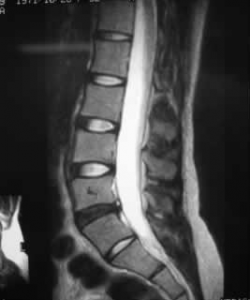by Dr. Demitri Adarmes
Let us begin by noting that degenerative disc disease is not technically a disease. Rather, it is the natural process of life; as time and nature wear away on the discs in your spine, these  discs begin to deteriorate and become weaker.
discs begin to deteriorate and become weaker.
The discs are, essentially, in your spine to act as a protective cushion between the bones in your back (vertebrae). Gravity constantly pushes down on the spine, but the discs protect your spine from breaking down by giving the bones a little bit of cushion from downward pressure.
Degenerative disc disease can, technically, occur in any spot along the spine; however, it happens most often in the lower back area and the neck region. As the discs in the spine become worse over time, they can cause all kinds of problems in the back and neck like:
- Osteoarthritis–a destruction of the cartilage that keeps bones at joints from rubbing against each other and hurting each other.
- Herniated discs–a tear in the outer disc lets some of the inner nucleus pulposus squeeze out and push on an adjacent nerve root leading to sciatica pain.
- Spinal stenosis–this is when the space that holds the spinal cord begins to narrow from arthritic overgrowth of surrounding bone and soft tissue.
Degenerative disc disease pain management becomes a common part of many peoples’ lives as they begin to grow a little bit older. There are a few things that can speed the disc degeneration as well.
Causes
As people get some age on them, the fluid in their discs that gives the discs nutrition begins to fade away slowly, so the discs can become less flexible and give less protection from compression-related incidents. This can occur at varying rates depending on the person.
Beyond that, the discs may begin to have micro-tears in their sides, which will allow the inner portion of the discs to seep out.
Disc injuries in young people, however, are often brought on by sharp physical injuries. For example, an athlete that twists quickly or falls roughly may herniate a disc. A person injured in a car accident or at work may sustain disc injury. This may either be a new injury or an exacerbation of pre-existing disc disease that may have been asymptomatic prior to the  incident.
incident.
In 40% of back pain cases, the problem lies with a disc degeneration condition. Thankfully most will resolve uneventfully. However, when chronic pain results, it may cause inability to work, play with one’s kids or participate in recreational activities.







Leave A Comment